How long do you grill steak? Believe it or not, there isn’t a cut-and-dry answer because of variables like steak thickness, type of grill, and how done you like your steak. This guide will give a comprehensive explanation on the most popular cuts and how long to grill each of them.
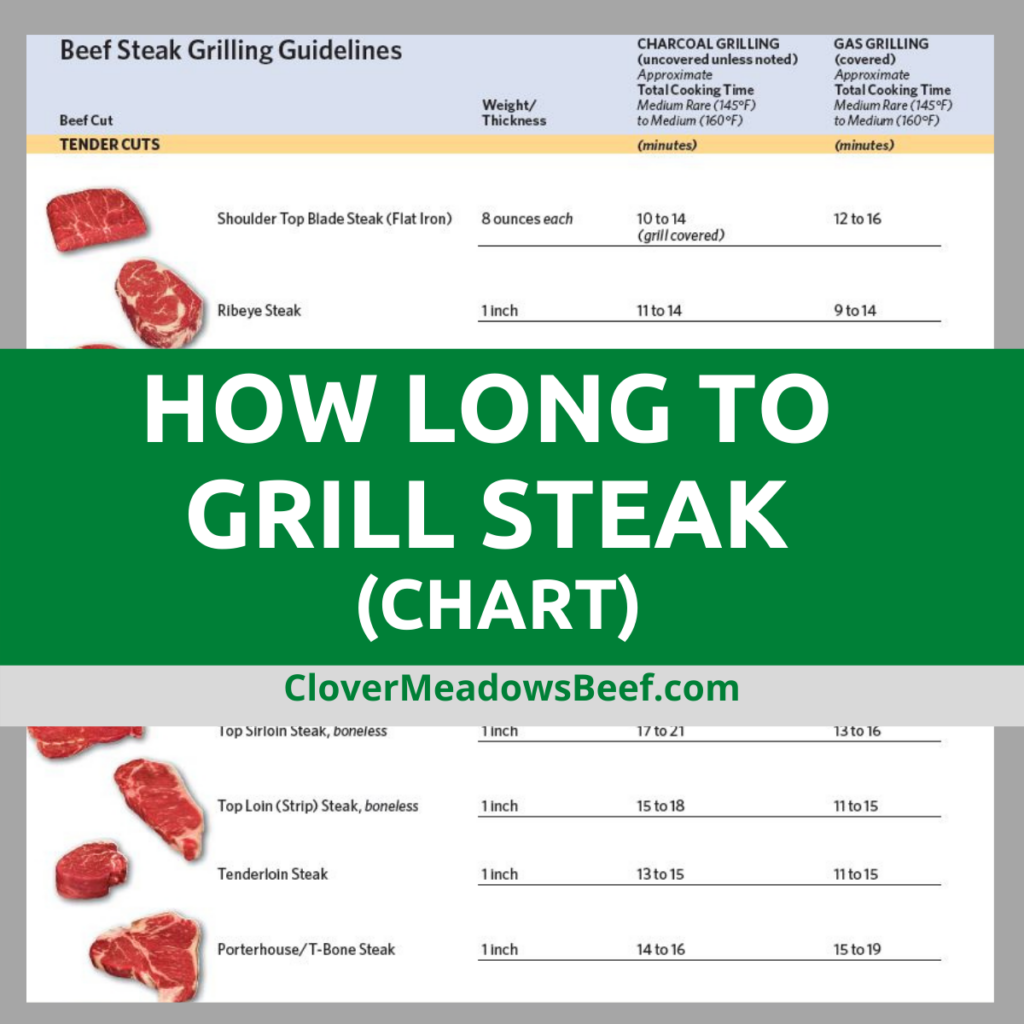
How long you grill a steak depends on lots of variables like the cut of steak, thickness, marbling, type of grill (gas or charcoal), and how done you like it. Although there’s not one “right” answer on how long to grill a steak, this guide will give a comprehensive explanation of the most popular cuts, advice on cooking times, thicknesses, techniques and more.
What’s the Best Cut of Beef to Grill?
At our house, we love ALL steak cuts. We really do. We’ve listed all of the most popular steak cuts so that you can pick which one is best for you and your dinner guests.
Thicker Cuts:
- Strip steak: A strip steak goes by many different names: New York Strip, Kansas City Strip or Top Sirloin, just to name a few. This is a tender steak that comes from the area just behind the ribs. It has a beefy flavor, but not as strong as a ribeye. A strip steak can either be bone-in or boneless. They’re usually between 8-14 ounces.
- Sirloin steak: Sirloin steaks are naturally lean. They’re usually between 5-10 ounces. They are a great larger steak when you’re on somewhat of a budget.
- Ribeye (or Rib) steak: A ribeye steak is the most flavorful, well-marbled cut of beef. It comes from the center of the cow in the rib section. A ribeye steak is a boneless steak, and a rib steak is bone-in (it’s also known as a bone-in ribeye). It’s usually between 8-14 ounces.
- T-Bone steak: The “T” shaped bone in the center of a T-bone steak joins two types of steak: filet and strip. When grilling, be sure the tenderloin (the less marbled side) is further away from the direct heat and the strip side is closer to the heat. A T-bone is a large steak and usually about 18 ounces. Another steak that’s similar to the T-Bone is the Porterhouse.
- Filet Mignon: Beef tenderloin is the most tender muscle on an animal and has very little fat. The leanness of the cut is why it’s sometimes wrapped in bacon. Filet Mignon should be cooked with quick, high heat (like grilling or pan-searing). Typically, a filet is 6-8 ounces.
Thinner Cuts:
- Skirt steak: Skirt Steak is a thin, flavorful cut of beef that’s from the diaphragm area. Because it’s a very thin cut with lots of fat it does especially well with high-heat searing. Be sure to slice skirt steak against the grain for added tenderness.
- Hanger steak: There is only one hanger steak per animal and it’s a flavorful cut. It comes from the belly of the cow – the part that “hangs” down. The hanger steak has a distinct look and is pointed and thinner at one end. It has a strong beefy flavor.
- Flank: Flank Steak is very distinct because of grains that run the length of the cut. It’s a lean and flavorful cut that can sometimes be slightly chewy. It’s a thin cut that will cook quickly, so it’s ideal for a weeknight meal. It comes from the belly of the cow near the back leg, so it’s a hard-working muscle that can be a tougher cut. Be sure to slice skirt steak against the grain for added tenderness.
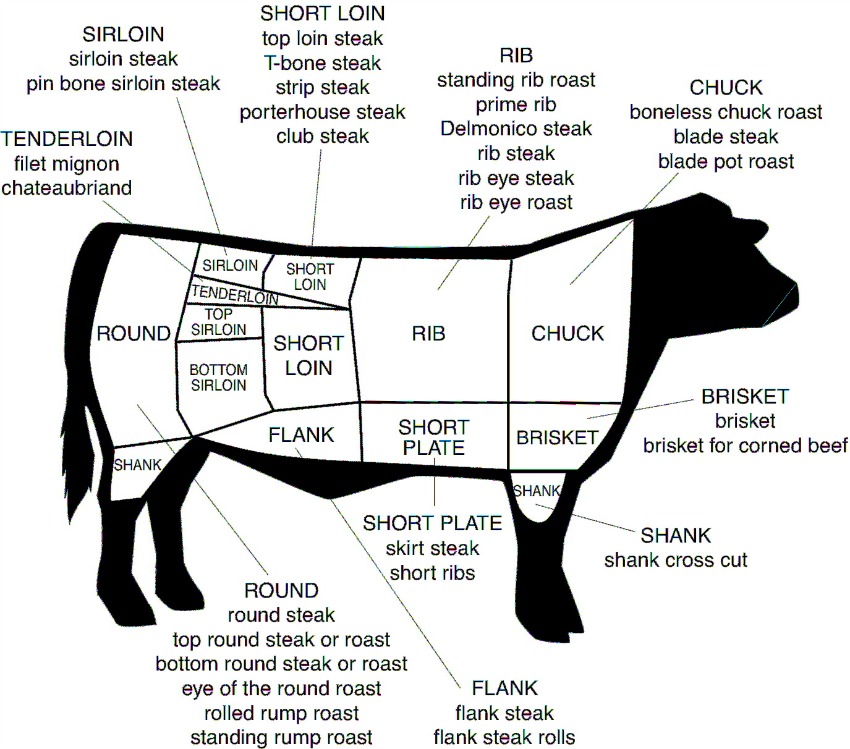
Bone-in or Boneless?
Several steak cuts can be purchased bone-in or boneless. Some research has shown that bone-in steaks have slightly more flavor and moisture than boneless steaks, but the difference is minimal. Our preference is boneless because having a bone can make cooking more difficult since the meat next to the bone cooks more slowly. That means depending on how long you cook, the meat closer to the bone can be slightly more or less cooked.
Best Steak Seasoning
Keep it simple! The best steak seasoning is salt and pepper.
When salt is added to beef, it breaks down the beef’s muscle protein, draws moisture to the surface of the meat, and has a hydrating effect. It ultimately creates a juicier steak.
When salting steak, it’s recommended to use ¾ teaspoon to 1 teaspoon per pound of beef. Salt about 1-hour before cooking, and be sure to apply the salt evenly to the front, back and side of the beef. If you struggle with applying it evenly, season from about two feet above the steak, and make it “rain” salt. This will avoid having a concentration of salt in one area and allows for even coverage. Thicker cuts of steak will typically need more salt than thinner cuts.
Kosher Salt is our go-to salt when salting steak or roasts. We like it because it has large, coarse grains and the large granules cling to the beef when seasoning. The large grains also make it easier to pinch and sprinkle. Different brands of kosher salt have different crystal sizes. We like this one the best.
Preparing Steaks: Room Temperature or Not?
There’s an ongoing debate among chefs on if steaks should be at room temperature before grilling or if it’s best to grill straight out of the refrigerator. The theory is that the “warmer” meat will cook more evenly. According to Cooks Illustrated magazine, there is no noticeable difference in taste or texture of steak whether or not you grill a steak straight from the refrigerator or let it warm up. We’ve tried both methods numerous times and we don’t notice a difference either.
Preparing the Grill
Your grill will need to be prepared in advance, just like the steaks. This is especially true if it’s the first time to use the grill this season.
We always recommend setting up a two-zone grill, or two temperatures in the grill. This works for both a gas and charcoal grill, and it will give you more control over how your steak cooks. One area should have intense, direct heat. The second area should have indirect heat. This allows you to first sear food on the hotter section of the grill and move it to the cooler zone to finish cooking through.
For the hotter, direct heat section of the grill, be sure to give your grill plenty of time to preheat. An easy test to do is the hand test. Hold your hand about 3 inches above the grill grate and count…”One-Mississippi, Two-Mississippi…” If you can hold it there for a second or two, the grill is hot and you’re ready to go.
A very general rule of thumb is that you will sear the steak on a hot zone for two minutes per side then move the steak to the low heat zone for the remaining minutes
.
How Long to Cook Steak on Grill?
So, how long do you actually cook a steak on the grill. The answer depends on the thickness of the steak and desired doneness. If you’re cooking a thinner steak, the cook time will be less than a thicker steak. If you like a medium-well steak, the cook time will be more than a medium-rare steak.
Although you can try and grill steak by time (see chart below), there’s only one way to get it right every time — you have to use an instant read thermometer.
An instant read thermometer is the only way to tell a steak’s doneness, not the color or the “feel” of the steak. If you don’t own an instant read thermometer, please get one right now! You will quickly make back any money you spent by never overcooking another piece of expensive meat again. Here’s our favorite.
Once you have an instant read thermometer, be sure you’re using it correctly. Insert the thermometer most of the way through the steak, and draw it out slowly. As you do, you’ll see the temperature change as you move the probe through the steak’s temperature gradients. The lowest number you see is the best indication of the internal doneness of that steak. Be sure to pull the steak off the grill about 5°F BEFORE it reaches the desired temperature. This allows for carryover cooking.
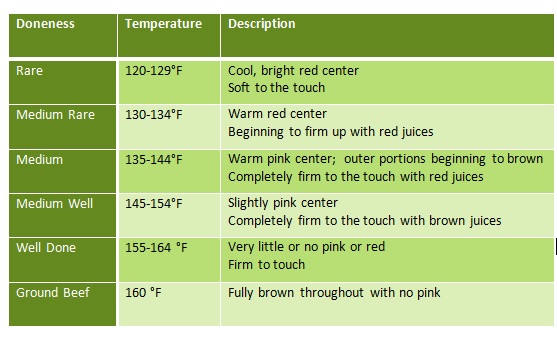
How to Cook a Rare Steak: 120-129°F
A rare steak should be warm through the center, lightly charred on the outside, and bright red in the middle. The meat should be soft to the touch, like raw meat, but browned on the surface. For a 1-inch steak, place steak on a hot grill for 5 minutes. Turn and continue grilling for another 3 minutes. For a 1 ½ inch steak, it will be approximately 6-8 minutes grilling time. Cook to an internal temperature of 120-129°F
How to Cook a Medium-Rare Steak: 130-134°F
Most steak aficionados want their steak done to medium-rare. It’s considered the recommended level for a good steak. A medium rare steak should be warm through the middle with most of the center pink in color with a hint of red. The top and bottom are caramelized to a dark brown color with good grill marks. For a 1-inch steak, place steak on a hot grill for 5 minutes. Turn and continue grilling for another 4 minutes. For a 1 ½ inch steak, it will be approximately 7-10 minutes grilling time. Cook to an internal temperature of 130-134°F
How to Cook a Medium Steak: 135-144°F
A medium-cooked steak is very warm and usually pink, not red. It should have a thick band of light pink through the middle but have more browned meat than pink overall. The steak will have a slightly drier and chewier. For a 1-inch steak, place steak on a hot grill for 6 minutes. Turn and continue grilling for another 4 minutes. For a 1 ½ inch steak, it will be approximately 10-12 minutes grilling time. Cook to an internal temperature of 135-144°F
How to Cook a Medium-Well Steak: 145-154°F
A medium-well steak is usually just slightly pink in the center and has lost much of its juices. This doneness of steak is for those who don’t want a lot of pink in their meat. For a 1-inch steak, place steak on a hot grill for 7 minutes. Turn and continue grilling for another 5 minutes. Cook to an internal temperature of 155 to 165 F
How to Cook a Well-Done Steak: 155°F+
In our opinion, anyone who wants to cook steak to well-done is ruining a good piece of meat. However, we know everyone has their own preferences, so we’ve included it in this list! A well done steak has no pink. It’s much tougher since all the juices have been cooked out of the beef. For a 1 ½ inch steak, it will be approximately 12-15 minutes grilling time. Cook to an internal temperature of 155°F+
Note that the USDA recommends cooking whole cuts of beef to an internal temperature of 145°F.
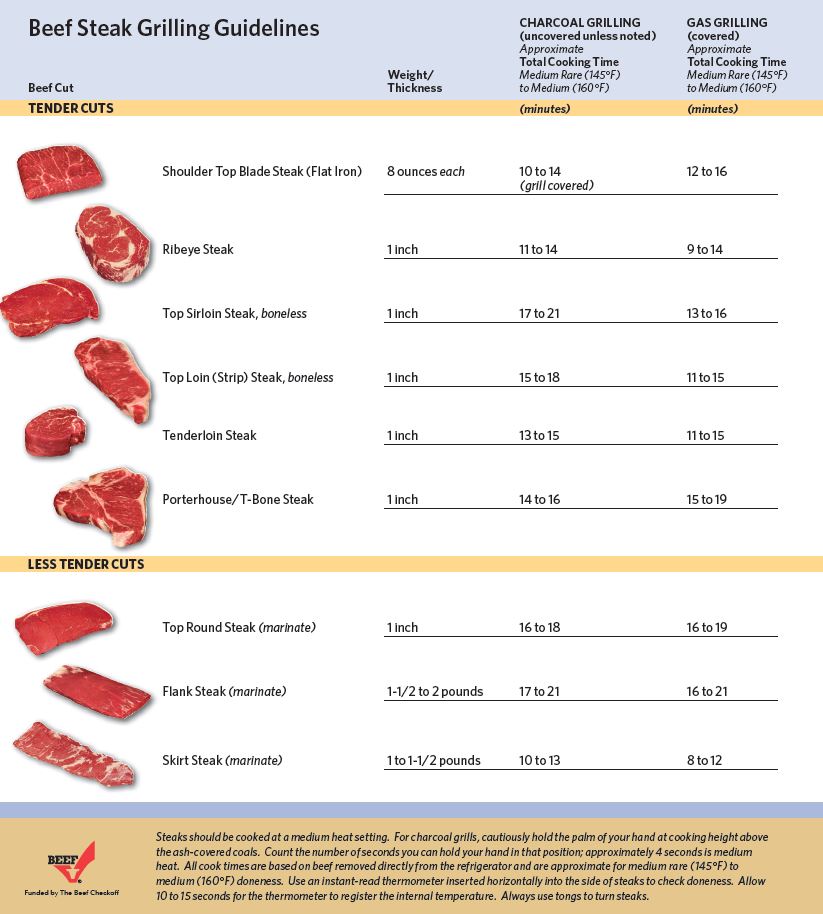
Can You Tell if Steak is Done by Touch? With Finger Test?
Because steaks muscles widen and relax in the cooking process, the meat gets firmer the more done it is. This makes it possible to touch the steak and guesstimate its doneness. Touch tests are very subjective, but they’re popular with some cooks. These tests are great when you’re in a pinch, but remember, the only real way to tell a steak’s doneness is by temperature, which requires a thermometer. Learn 3 types of steak touch tests here.
Carryover Cooking
Another tip to achieve the perfect steak at home is to be mindful of carryover cooking, which is the rise in the steak’s temperature once it leaves the heat source.
When you take a temperature reading of steak, you’re not looking for the specific number in the chart above. Rather, you want to pull your steaks off at a high enough temperature so that carryover cooking will do the rest of the work and raise the temperature of the steak to your desired doneness.
This means it’s best to pull your steaks off the heat source when the thermometer reads about 5-10°F lower than the desired doneness.
Let It Rest
It’s very important to let your steak rest for about 5 minutes before slicing. Why? Meat is a muscle and it has two main parts – protein and water.
When meat is raw, it’s about 70-75% water. If you’ve ever cut into raw meat before, you know that you barely lose any liquid.
When steak is cooked, the muscle fibers contract because of the increased temperature. Then, the water is squeezed out of the fibers and the liquid moves towards the center of the steak.
If you cut meat before it rests, the juice goes directly on your plate because the juices haven’t had a chance to be reabsorbed by the meat yet.
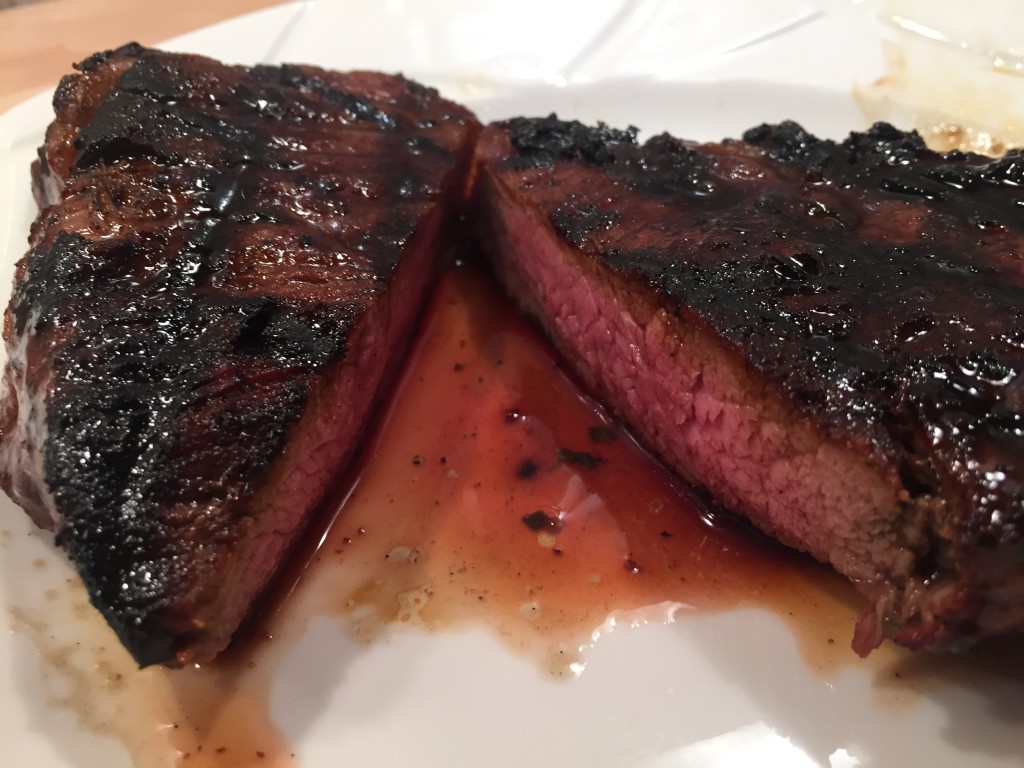
There are lots of guidelines and studies about how long should steak rest. The three most common guidelines we’re aware of are to let the meat rest for…
- 5-minutes for every inch of thickness
- 10-minutes for each pound of meat
- let meat rest for as long as you cooked the meat
FAVORITE KITCHEN PRODUCTS
ONE MORE THING!
Do you want to learn more about beef? Join our weekly e-newsletter where we share farm happenings, recipes and beef availability. Sign-up and get a cheat sheet with 9-must-ask questions before buying beef directly from a farmer. Or, we have an entire ebook about beef that goes through purchasing and preparing beef from a cattle farmers perspective.
Here are a few other links you may like:
- What everybody ought to know about beef cuts
- Buying a Cow. How Much Beef Is It?
- 7 Steps to Grilling a Steak to Perfection
- How We Raise Our Grass Fed Beef
- Easy Beef Brisket Recipe (oven-roasted)
- The Best Farm Books for Kids
Disclosure: This post contains affiliate links. This means if you click on the link and purchase the item, we will receive an affiliate commission at no extra cost to you. All opinions are our own and we only recommend products that we truly believe in.
We participate in the Amazon Services LLC Associates Program, an affiliate advertising program designed to provide a means for us to earn fees by linking to Amazon.com and affiliated sites. See our disclosure policy for more details.

